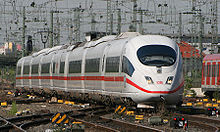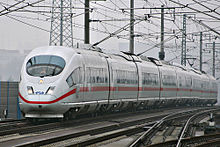- ICE 3
-
This article is about a high-speed train design. For the Bridgman form of water ice, see Ice III.
DB/NS Class 403/406/407 
ICE 3 on the Cologne–Frankfurt high-speed rail lineIn service 2000 - Manufacturer Siemens Family name Velaro Number built 50 trainsets (ICE 3)
17 trainsets (ICE 3M/F)Formation 8 passenger cars per halftrain, optional double traction giving 16 passenger cars Capacity 441 (ICE 3)
430 (ICE 3M)Operator Deutsche Bahn
Nederlandse SpoorwegenSpecifications Width 2,950 mm (9 ft 8 in) (ICE 3/ICE 3M)
3,265 mm (10 ft 8.5 in)(?)
(Velaro D)Maximum speed 320 km/h (199 mph) (service) Weight 409 t (403 long tons; 451 short tons) (ICE 3)
435 t (428 long tons; 480 short tons) (ICE 3M)Power output 8,000 kW Power supply Overhead catenary Electric system(s) 15 kV AC, 16.7 Hz
1.5 kV DC (ICE 3M)
3 kV DC (ICE 3M/Velaro D)
25 kV 50 Hz AC
(ICE 3M/F/Velaro D)Current collection method Pantograph Safety system(s) Sifa, PZB90, LZB (ICE 3)
Sifa, PZB90, LZB80, Crocodile, TVM430, KVB, ATB, Eurobalise (ICE 3M)Gauge 1,435 mm (4 ft 8 1⁄2 in) Standard gauge ICE 3 is a family of high-speed EMUs of Deutsche Bahn. It includes classes 403 and 406, which are known as ICE 3 and ICE 3M respectively. Four multisystem trains, known as ICE International, are owned by Nederlandse Spoorwegen (Dutch Railways).
Loosely based on the ICE 3, Siemens developed its Siemens Velaro after the completion of the ICE 3 project; these trains will enter service as class 407 in late 2011.
Contents
Class 406
 ICE 3 (Class 406) approaching Frankfurt (Main) Hauptbahnhof
ICE 3 (Class 406) approaching Frankfurt (Main) Hauptbahnhof
The ICE 3M (Class 406; M for multisystem) was developed to operate international services under the four different Railway electrification systems in use on Europe's main lines and with support for various train security systems. The Deutsche Bahn (DB) ordered 13 of these units in 1994, the NS (Nederlandse Spoorwegen) four, making sure that the demands of the Dutch rail network are taken care of. Though these trains carry NS logos, the DB and NS trains together form a pool and therefore the NS trains may operate DB services also. As of 2007, the train is licensed for operation in the Netherlands, Belgium and France. Currently those trains are used for cross-border runs between Netherlands, Germany, Belgium and France. On the French LGV Est some trains reach a regular top speed of 320 km/h (199 mph).
In Belgium, the train was licensed in 2002 to run on the classic 3 kV DC lines with speeds up to 160 km/h (99 mph) and, from December 2004, also on the new 25 kV AC high-speed lines, but initially limited to 250 km/h (155 mph) instead of 300 km/h (186 mph).[1] Problems with flying gravel and its frictionless linear eddy current brake came up during testing. In order to limit the creation of tornado-like vorticles that pick up gravel and to limit damage from flying gravel to the train, spoilers have been added under the car joints, under the carbody next to the bogies and under the powered axles on the bogies.
The linear eddy current brake, which is required for higher speeds, cannot yet be used, because the magnetic field would rip off the magnetic covers of some trackside equipment; those covers will have to be replaced by non-magnetic ones according to the EU Technical Specifications for Interoperability for international rail traffic in Europe.
As in Belgium, licensing procedures for France took five years to be completed. Trial runs were completed in late 2005 and the same two problems were encountered as in Belgium: loose gravel damage and possible side-effects of the brakes. ICE 3Ms were allowed on the LGV Est and started service there on 20 June 2007, mixed with TGVs. Since December 2007, DB operates ICE 3M trains from Frankfurt Hbf to Paris Est, initially with five daily runs between both cities. The six trains for running into France (designated ICE-3 MF, indicating multisystem France) were modified at Bombardier's Hennigsdorf plant and were extensively tested on Siemens' test site in Wegberg-Wildenrath before the modified trains re-entered commercial service.
Despite this the "French" subset of six class 406 trains have suffered from reliability problems, so that some Paris-Frankfurt services are operated instead by French TGVs under the "Alleo" joint venture between DB and SNCF.[2]
In Switzerland, licensing took only six months.[1] The train lost its Swiss licence in 2006 when the ZUB and Integra safety systems were removed, which interfered with the French safety systems TVM430 and KVB.[citation needed] This was not a significant setback, as the Amsterdam-Basel service was the sole presence in Switzerland.
The 17 class 406 sets were built by the same consortium as the class 403. They were first introduced from November 2000 on services between Cologne and Amsterdam. Since December 2002 they have also been operating three journeys daily each way between Frankfurt and Brussels (increased to four per day since December 2010).[2]
Class 407
 Front car of the most recent ICE 3 version (class 407), a Siemens Velaro D, on display at InnoTrans 2010. These trains are due to for delivery in 2011 and 2012.
Front car of the most recent ICE 3 version (class 407), a Siemens Velaro D, on display at InnoTrans 2010. These trains are due to for delivery in 2011 and 2012.
 Interior view showing smart glass separating driver's cab
Interior view showing smart glass separating driver's cab
Deutsche Bahn placed an order for fifteen trains valued €500 million in November 2008.[3] On 18 April 2010 Deutsche Bahn presented the first Velaro D at Siemens' Krefeld plant.[4] It is designed for operation at up to 320 km/h (199 mph), is wider, quieter and more energy-saving, should be less susceptible to malfunctions than its predecessor, and incorporates additional crashworthiness and fire safety measures.[4] At the end of 2011 the new train will enter service, designated Class 407 or new ICE 3: it will be used mainly for international services from Germany to France, Belgium and the Netherlands.[5] The new type's safety measures are in line with the new specifications for operating passenger trains inside the Channel Tunnel, allowing the Class 407 to be used on the services that DB plans to operate from London to Amsterdam and Frankfurt in 2013.[6]
References
- ^ a b Harmonisierungsdefizite am Beispiel von Auslandszulassungen des Triebzuges ICE 3, in "Elektrische Bahnen", Vo. 103 (2005), pages 147-149
- ^ a b "The German ICE family". Modern Railways (London): pp. 70–71. December 2010.
- ^ "Siemens receives order over 15 high-speed trains from Deutsche Bahn" (Press release). Siemens. 17 December 2008. http://w1.siemens.com/press/en/presspicture/2008/mobility/imo200812006-04.htm. Retrieved 2008-12-27. Reference Number: I MO 200812.006-04.
- ^ a b "DB unveils next-generation ICE". Railway Gazette International (London). 28 April 2010. http://www.railwaygazette.com/news/single-view/view/10/db-unveils-next-generation-ice/browse/1.html. Retrieved 2010-05-04.
- ^ "Neuer ICE: Hightech gegen die Achsenkrise" (in German). Spiegel Online. 28 April 2010. http://www.spiegel.de/reise/aktuell/0,1518,691882,00.html. Retrieved 2010-04-28.
- ^ Fender, Keith (December 2010). "DB unveils plans for London services". Modern Railways (London): pp. 68–69.
External links
- ICE 3 for Germany and the Netherlands Siemens Page
German ICE Class Trainsets run in Germany (ICE) Export trainsets (Velaro) Classes of German EMUs and battery railcars BR number: 401 | 402 | 403 | 403 alt | 406 | 407 | 410 | 411 | 415 | 420 | 421 | 422 | 423 | 424 | 425 | 425 alt | 426 | 426 alt | 427 | 427 alt | 428 | 430 | 440 | 442 | 450 | 465 | 485 alt | 490 | 491
Older, pre-1968 classes: ET 11 | ET 25 | ET 26 | ET 27 | ET 31 | ET 41 | ET 51 | ET 55 | ET 65 | ET 82 | ET 85 | ET 90 | ET 91 ("Gläserner Zug")Battery railcars: 515 | 517 | ETA 150 | ETA 176 | ETA 178 | ETA 179
S-Bahn EMUs:
Berlin: 475 | 476 | 477 | 480 | 481 | 485 | ET 125 | ET 165 | ET 166 | ET 167 | ET 168 | ET 169 | ET 170 | 270Hamburg: 470 | 471 | 472 | 473 | 474 | ET 99 | ET 170 | ET 171

Train types in the Netherlands Diesel Multiple Units (DMU) DM'90 (Buffel) • Lint 41/H • GTW (Spurt / Velios)Electric Multiple Units (EMU) Mat '64 (Plan T / V) • SGM (Sprinter) • ICM (Koploper) • DD-AR • (V)IRM • Thalys PBA / PBKA • ICE 3M • Protos • GTW (Spurt / Velios) • SLT • V250Categories:- Electric multiple units of Germany
- Deutsche Bahn locomotives
- InterCityExpress
- Passenger train running at least at 300 km/h in commercial operations
Wikimedia Foundation. 2010.


